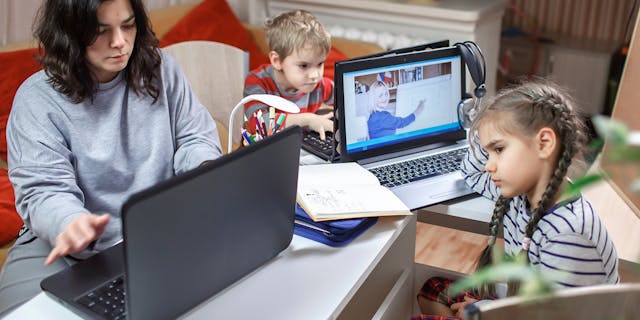El Roberts’ alarm blares at 4:50 a.m. each day, alerting her of the need to wake up to head to figure skating practice before school. When she returns, instead of getting on the bus, she opens up her laptop, where she participates in virtual classes for roughly two hours. Meanwhile, her mother, Deborah Fairclough, either shares an office with her daughter while working as a mobile dog groomer, or checks in from afar, monitoring her class schedule so she knows when to not disturb her daughter.
“Ultimately, we are responsible for the children getting their work done or not,” Fairclough says about parents whose children study online.
Roberts is one of hundreds of thousands of students forgoing the brick-and-mortar school experience in favor of virtual programs, which have been lauded by some observers for their flexibility and panned by others for their ineffectiveness.
But for many families, this kind of learning program makes sense with their children’s increasing involvement in activities. Much like adults who opt for remote work, they’re seeking a better school-life balance.
“My daughter was doing competitive dance and would spend three to four hours in the studio then come home and do two to three hours of homework; she had no life,” says Angie Price, who eventually enrolled her daughter Aubrey in virtual school in 2018. “By the weekend, we were wiped out. This gave us so much more freedom.”
The decision comes with a trade-off, with parents having to commit to the school in the same fashion as their child — often signing literal contracts to ensure they understand the undertaking.
Their role is very influential in whether their child will succeed in a virtual school like the one where Molly Hamill teaches fifth grade.
“In my opinion, when the kids have good support from the parents at home, they can thrive in a program like this … but if they have some struggle and not a lot of parent support, it can be hard,” she says.
Being a virtual teacher, she adds, “almost feels like being a case worker; you have to talk to parents and help them understand their role and nag them a bit to say, ‘Check in on your kid.’”
Flexibility Entices Some to Switch to Virtual
Roughly 1.7 percent of children in the U.S. are enrolled full time in virtual schools, according to DLAC, an organization focused on advancing digital learning. That’s a dip since the 2020 peak, when nearly every child was studying remotely during the pandemic, but the population is holding steady.
Ten years ago, observers say, not many families thought virtual school was a viable option. But the abrupt shift to remote instruction during the COVID-19 health crisis made many more students realize they preferred an alternative to physically showing up to a classroom in person.
States are also increasingly allowing families to spend public school dollars on enrolling their children at alternative education institutions thanks to the “school choice” movement.
“That’s putting the power back into the parents’ hands,” says Nik Osborne, senior vice president of partnerships and customer success at Pearson, a long-standing online learning provider. “The idea that parents are given more choice in their child’s schooling has opened up concepts for them that didn't exist five to 10 years ago.”
For some, online school may just be the most accessible option: Hamill, who teaches in California, points out that many children have no way to get to school, as buses are not required in the state and a parent may be unable to take or pick them up.
For families who want their children to learn at home, virtual school can be a less labor-intensive endeavor for parents than directing their own homeschool. Lisa Yarberry, who was a music teacher for a dozen years at a brick-and-mortar school, was initially homeschooling her children before making the switch to Kansas Connections Academy, a virtual public school program.
“Parent-led curriculum got a bit overwhelming as they got older, and the curriculum got more rigorous and time-consuming,” says Yarberry, whose three daughters are all now in virtual school. “This takes the burden and workload off me, and they're enjoying it more than homeschooling. They love the live lessons, the teachers and the classmates they have online.”
Yet Fairclough, whose daughter joined virtual school this year as an eighth grader, acknowledges virtual schooling is not for everyone; her son, for example, is a junior in a brick-and-mortar high school.
And just like with students, virtual schooling may not be for all parents, either.
“It often requires a parent really overseeing an education at home, and there's a limited number of families who can do that,” Robin Lake, director of the Center on Reinventing Public Education, told EdSurge previously.. “It’s a rare student that's so motivated and driven that they'll just succeed on their own with a virtual program.”
Price, a virtual school second grade teacher whose daughter Aubrey graduated from New Mexico-based PECOS Cyber Academy last year, felt an initial apprehension when signing up her daughter for sixth grade online — and still sees that anxiety in parents today.
“I know when we first started, it was, ‘What have we gotten into?’” she says. “When we get new families and they're overwhelmed, I say, ‘Hang in there, give it two weeks.’ You have to find a rhythm and routine that works for you — as long as they know it’s flexible up to a certain point.”
The Commitment Behind the Classes
Worry from families may stem from the fact that many virtual school districts require an adult to sign a contract of sorts explaining what exactly they are on the hook for. These adults are often dubbed “learning coaches,” as they can include a parent, grandparent or older sibling.
Oklahoma-based Caney Valley Public Schools offers a 10-page contract for students and parents to sign, requiring 20 hours a week in classes and daily email check-ins, while the Pennsylvania Virtual Charter School outlines expectations including that parents sit directly next to their elementary-aged children during live classes and create participation goals for their child.
Connections Academy and Stride — two of the largest and longest-running providers of virtual schools — do not require a contract, necessarily, but take caution to fully explain to learning coaches exactly what they are signing up for.
K12, which is under the parent company Stride, provides a "Learning Coach Orientation" for parents to understand the commitment, learn how to use the platform and connect with other learning coaches. Connections Academy, a subsidiary of its parent company Pearson, provides multiple sessions during parent orientation explaining the commitment.
“We want them to understand what they're signing up for; you can’t leave a second grader to figure it out on their own,” Osborne says. “One of our big things is we want to make sure not only the experiences for families are positive, but the outcomes are positive. And you can't have that without an involved learning coach.”
The parent contracts, when they do exist, are not a be-all-end-all. Hamill, the California-based fifth grade teacher in a virtual program, says similarly to at a brick-and-mortar school, there are more involved parents — one student’s father who works from home shares an office with his fifth grade son — and those who need more prodding to ensure their child is staying on track. In her school’s case, parents are required to sign a pledge that they will be in the same vicinity as their children from 8:45 a.m. to 4 p.m.
“The reality is they don’t always follow the contract, and then you have to have tough conversations, saying ‘This is part homeschooling and part virtual learning,’” she says. “Some parents are really involved and good at monitoring their children and messaging me, and some are less hands-on; those I have to reach out to, like, ‘Hey, Serenity wasn't in class, can you check on her?’”
Michael Kooi, superintendent at Georgia Cyber Academy, does not think the commitment for a parent is especially novel.
“I think the role of the parent is largely the same as it is in a brick-and-mortar: it’s just the child is at home and the parent needs to make sure they access their education,” he says. “In the same way they'd drive their kids to school, we want to make sure they're getting on the computer and accessing classes on time.”
Some schools are more structured than others, requiring students to watch sessions live, in real time, while others allow children to access recordings at their own pace. Different formats require different support from learning coaches.
“It is something we really emphasize, of ‘Hey, you need to be present,’ especially with the younger ones,” Kooi says. “They need to make sure their children are logging in on time and that's definitely part of the expectation, but the older they get, they can do that themselves.”
Price had to make the switch to teaching in a virtual classroom when her daughter wanted to attend virtual programming as a student, as a way to ensure there was an adult in the house with her during school hours. But Price says the online programming, all held in one spot and made easily accessible, felt more manageable than when her other two children were in physical schools.
“In the brick-and-mortar setting, there was homework and projects and different things going on; it was more chaotic,” she says. “It just seemed like things calmed down a lot more with virtual school and I was able to stay involved, so I never felt like I was blindsided.”
Helping Parents Support Students
Virtual schools often have a team of intermediaries whose role it is to help both parents and teachers in the online space. For example, at Georgia Cyber Academy, there is a “family engagement team” that serves as a point of contact for concerns or questions.
Some schools bridge the gap by having what they deem “mentors,” who serve as a mix between a teacher and wrap-around support staff. Brianna Capson, a mentor at Michigan Virtual Academy who recently won Mentor of the Year, oversees roughly 170 students, doing everything from teaching study skills to advising on composing emails to teachers. Most of Capson’s students have an “online” block within their day at a brick-and-mortar school, visiting her physical classroom where she is available to help. She also has a handful of fully virtual students, who also have the option to visit her classroom.
“It’s trying to help them be successful in their courses, whether it’s with pacing, technology or reaching out,” she says.
That can be particularly helpful for students who are attending virtual school because they did not find success in its brick-and-mortar counterpart and are now grades behind in learning. Kooi says that every year his Georgia district receives students who are “not just one year behind, but two or three years, for whatever reason.”
For Fairbough, knowing her newly-14-year-old daughter has fewer worries surrounding school — both navigating school-life balance, a slate of health issues and the typical social anxiety that comes with being a middle school girl — makes her own contributions worth it.
“As a parent and learning coach, it takes it off my plate of, ‘Is my child going to be anxious?’” she says. “To me, it's such a good alternative, to take that anxiety out of your day and see how much better you can perform.”


